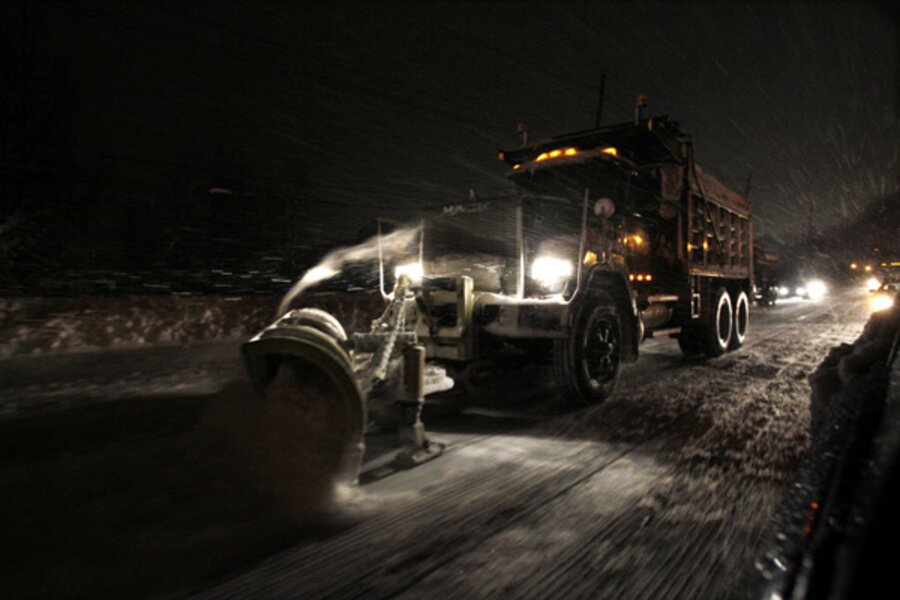Winter storms zap city budgets. Will FEMA help with snow plowing costs?
Loading...
| New York
Snow-battered states and cities are crying “uncle,” as in, "Uncle Sam, help me with my snow removal budget."
Winter is not even half over, but already many cities and towns have used up the money they'd set aside to plow snow-covered roads, spread sand and salt, and remove snow berms piled up from plowing operations. With another winter storm sweeping across the nation on Tuesday and Wednesday, they will have to take from other accounts to pay for yet more plowing.
Many mayors and governors hope they can get at least some of that money back, however, by tapping the federal government, mainly the Federal Emergency Management Agency (FEMA).
“Given the fiscal reality, getting some help is very important,” says Peter Boynton, commissioner of emergency management and homeland security for the state of Connecticut. “Governor [Dannel] Molloy has directed our agency to work with every town to make a thorough determination if we are eligible, and if we are eligible we are going for the aid."
Many cities and other states are no doubt following Connecticut’s example. New York City has already run through its $38 million snow-removal budget, and New Jersey has exhausted its allowance of $20 million. Small towns in Massachusetts like Tyngsborough, which spent $250,000, have also used all their snow-removal money and plan to ask for federal aid.
Washington is more than aware of the chain of snow storms that has buried the nation under white mounds. In fact, on Monday FEMA issued warnings for the latest storm system now bearing down on the Midwest.
"A storm of this size and scope needs to be taken seriously," said FEMA Administrator Craig Fugate, noting that the storm could affect 100 million people. “Already this winter we've seen how snow and ice can knock out power and affect transportation.”
According to FEMA, the coming storm’s first impact in the Midwest could include heavy snow, destructive ice, tornadoes, and bitter cold. The storm will move into the Northeast on Wednesday, when it is expected to dump heavy snow in inland areas.
FEMA also said it has moved personnel to Oklahoma, Kansas, Missouri, and Indiana at the request of the states to help coordinate additional support, if it is needed.
What many communities really want from FEMA is money. Getting it requires a state or a community to meet two main requirements.
First, the jurisdiction asking for aid must have had a “record or near-record” snowfall within a 48-hour period. A near-record snowfall is within 10 percent of the previous record.
Second, the state or county must have exceeded the costs of snow removal for the state and the area on a per capita basis, based on a FEMA formula, within that time constraint. Costs that are eligible include snow removal, salting and sanding, any sheltering expense, overtime, and hiring private contractors to remove snow. But if a town has insurance, it won’t be able to collect from FEMA if the insurer pays.
In Connecticut, Mr. Boynton asked all 169 towns in the state to send him information on their snow-removal costs. And his department is working with the National Weather Service (NWS) to obtain official counts of the snowfall total.
As of Monday, Boynton had received replies from 157 towns. “The preliminary numbers look very, very good, but we still don’t know if we will be eligible for federal disaster aid,” he says.
The storm that really whacked Connecticut was the Jan. 11-12 blizzard, which dumped between 14 and 30 inches of snow. The state spent $4.5 million on that one storm, says Kevin Nursick, a spokesman for the state Department of Transportation. The state has spent $18.5 million of its $26.5 million snow-removal budget for the season, he estimates.
Boynton expects that there has been enough of the white stuff to constitute a record for most Nutmeg State municipalities. NWS is convening a climactic panel to make an official determination about whether it was a record storm, he says.
Even if a community proves it had a record snowfall over 48 hours, that is it no guarantee of a FEMA check. For example, Connecticut applied for federal aid last March after storms ravaged and flooded the state. “We have to go through with FEMA to make sure all the numbers meet their criteria,” says Boynton. “FEMA has a fairly high degree of validation of costs and it has to be validated within the eligible area.”
Last year, most of FEMA’s snow disbursements were in states not normally considered part of the snow belt. As of Jan. 31, FEMA had sent checks totaling about $169 million to Virginia, Maryland, Pennsylvania, and the District of Columbia. But the largest check was for $68 million to Oklahoma for the blizzards of December 2009 and January 2010. The agency is still processing other applications, so more checks may be in the mail, assuming the US Postal Service letter carriers can get through the snow drifts.
Leigh Montgomery in Boston contributed to this report.





